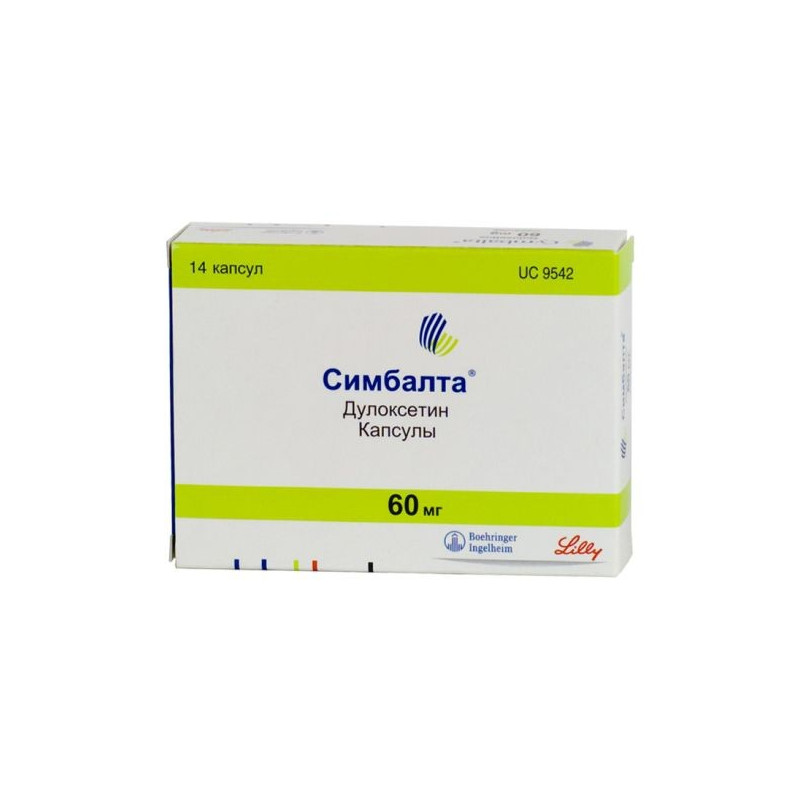



 All payments are encrypted via SSL
All payments are encrypted via SSL
 Full Refund if you haven't received your order
Full Refund if you haven't received your order
14 pcs.
Cymbalta has an antidepressant effect. duloxetine is an antidepressant, a serotonin and norepinephrine reuptake inhibitor, and weakly inhibits dopamine uptake, without significant affinity for histaminergic, dopaminergic, cholinergic and adrenergic receptors. The mechanism of action of duloxetine in the treatment of depression is to suppress the reuptake of serotonin and norepinephrine, resulting in increased serotonergic and noradrenergic neurotransmission in the CNS. Duloxetine has a central mechanism for the suppression of pain, which, first of all, is manifested by an increase in the pain sensitivity threshold in pain syndrome of neuropathic etiology.
Carefully
When exacerbation of manic / hypomania state, epileptic seizures, mydriasis, abnormal liver function or kidney, with the probability of suicidal attempts.
Due to lack of experience with Cymbalta during pregnancy, the drug should be prescribed during pregnancy only if the potential benefit to the patient greatly exceeds the potential risk to the fetus. Patients should be warned that in the event of pregnancy or its planning during the period of treatment with duloxetine, they should be informed about this by their attending physician.
Due to the lack of experience with duloxetine in women during breastfeeding, breastfeeding is not recommended during duloxetine therapy.
Simbaltu prescribed inside, regardless of the meal.
Capsules should be swallowed whole without chewing or crushing. Cymbalta cannot be added to food or mixed with liquids, as It may damage the enteric capsule shell.
The recommended initial dose of Cymbalta is 60 mg once a day. If necessary, you can increase the dose to the maximum dose - 120 mg per day in 2 divided doses. A systematic assessment of the administration of Cymbalta at a dose of over 120 mg was not carried out.
In the terminal stage of chronic renal failure (CC less than 30 ml / min), the initial dose of Cymbalta is 30 mg once a day.
Most often (10%): dizziness (except vertigo), dry mouth, nausea, constipation, sleep disturbances (drowsiness or insomnia), headache (less often than in patients receiving placebo). Less often (1-10%): diarrhea, vomiting, tremor, loss of appetite, weight loss, weakness, increased sweating, hot flashes, blurred vision, anorgasmia, decreased libido, delayed and impaired ejaculation and erectile dysfunction. A slight increase in fasting blood glucose concentration in patients with painful diabetic neuropathy. Dizziness, nausea, headache were noted as frequent adverse effects with the withdrawal of duloxetine.
Monoamine oxidase inhibitors (MAOIs). In patients receiving a serotonin reuptake inhibitor in combination with an MAOI, there were cases of serious reactions, sometimes fatal, among which were hyperthermia, rigidity, myoclonus, peripheral disorders with possible sharp fluctuations in vital signs and changes in mental status, including pronounced arousal with the transition to delirium and to whom. These reactions were also observed in patients who, shortly before the administration of an MAOI, a serotonin reuptake inhibitor was canceled. In some cases, patients had symptoms characteristic of neuroleptic malignant syndrome. The effects of the combined use of duloxetine and MAOI have not been evaluated in humans or animals. Therefore, given the fact that duloxetine is an inhibitor of both serotonin and norepinephrine, it is not recommended to take duloxetine in combination with an MAOI or for at least 14 days after stopping the treatment of MAOI.Based on the duration of the half-life of duloxetine, you should take a break for at least 5 days after the end of douloxetine taking before taking an MAOI.
Exacerbation of manic / hypomanic state: as with the use of similar drugs that affect the central nervous system, duloxetine should be used with caution in patients with a history of manic episodes.
Epileptic seizures: as with the use of similar drugs that affect the central nervous system, duloxetine should be used with caution in patients with history of epileptic seizures.
Mydriasis: cases of mydriasis have been observed when taking duloxetine, so care should be taken when prescribing duloxetine in patients with elevated intraocular pressure or in individuals at risk of developing acute angle-closure glaucoma.
Impaired liver or kidney function: in patients with severe impaired renal function (creatinine clearance <30 ml / min) or severe liver failure, an increase in plasma duloxetine concentration is observed. If these patients are clinically based on duloxetine, lower initial doses should be used.
Suicidal attempts: with depression there is a possibility of suicidal attempts, which may persist until the onset of persistent remission. Careful observation of patients at risk is needed.
Reported several cases of overdose with simultaneous ingestion of up to 1400 mg of the drug that did not have fatal consequences. Overdose can be accompanied by the following symptoms: tremor, clonic convulsions, ataxia, vomiting and loss of appetite.
Treatment with overdose. The specific antidote is not known. It is recommended to monitor cardiac activity and monitor key vital signs, along with symptomatic and supportive treatment.
At a temperature of 15-30 ° C, in places inaccessible to children.
2 years.
